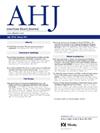主动脉缩窄修复后成人左心房僵硬、肺充血和有氧能力受损的关系
IF 3.5
2区 医学
Q1 CARDIAC & CARDIOVASCULAR SYSTEMS
引用次数: 0
摘要
背景:左心房(LA)僵硬与获得性心力衰竭患者的肺充血和运动不耐受有关,但尚未对成人主动脉缩窄(COA)进行研究。我们假设,与对照组相比,患有COA的成年人LA僵硬增加,反过来,心脏储备更差,肺充血和有氧能力受损,并且LA僵硬指数与COA组中这些异常的存在有关。方法:在这项前瞻性研究中,46名COA修复的成年人和46名对照组进行了运动超声心动图和过期气体分析。静置时LA刚度以侧向E/ E′和LA储层应变(E/ E′/LARS)之商进行评估。通过运动引起的LA储层应变、右心室自由壁应变/右心室收缩压(RV-PA耦合)和心输出量(CO)的变化来评估心脏储备。肺超声检查肺充血情况。结果:COA组LA僵硬指数较高(0.47±0.12 vs 0.14±0.09,p0.42),心脏储备、肺充血和有氧能力较差。与左室刚度指数相关的有左室后负荷高、左室肥厚和心房颤动。结论:这些数据表明,在COA患者中,LA僵硬、肺充血和运动不耐受之间存在机制联系,并且LA僵硬指数的相关性可能为治疗干预提供可行的目标,以改善该人群的预后。本文章由计算机程序翻译,如有差异,请以英文原文为准。
Relationship between left atrial stiffness, pulmonary congestion, and impaired aerobic capacity in adults with repaired coarctation of aorta
Background
Left atrial (LA) stiffness is linked to pulmonary congestion and exercise intolerance in patients with acquired form of heart failure but has not been studied in adults with coarctation of aorta (COA). We hypothesized that adults with COA had increased LA stiffness, and in turn, worse cardiac reserve, pulmonary congestion, and impaired aerobic capacity compared to controls, and that LA stiffness index was associated with the presence of these abnormalities in the COA group.
Method
In this prospective study, 46 adults with repaired COA and 46 controls underwent exercise echocardiogram with expired gas analysis. LA stiffness was assessed at rest as the quotient for lateral E/e’ and LA reservoir strain (E/e’/LARS). Cardiac reserve was assessed by exercise-induced change in LA reservoir strain, right ventricular free wall strain/right ventricular systolic pressure (RV-PA coupling), and cardiac output (CO). Pulmonary congestion was assessed by lung ultrasound.
Results
The COA group had higher LA stiffness index (0.47 ± 0.12 vs 0.14 ± 0.09, P < .001), and in turn, worse cardiac reserve, pulmonary congestion, and aerobic capacity compared to controls. Within the COA group, those with high LA stiffness index (>0.42) had worse cardiac reserve, pulmonary congestion, and aerobic capacity. The correlates of LA stiffness index were high pulsatile left ventricular (LV) afterload, LV hypertrophy, and atrial fibrillation.
Conclusions
These data suggest a mechanistic link between LA stiffness, pulmonary congestion, and exercise intolerance among patients with COA, and the correlates of LA stiffness index may provide viable targets for therapeutic interventions to improve outcomes in this population.
求助全文
通过发布文献求助,成功后即可免费获取论文全文。
去求助
来源期刊

American heart journal
医学-心血管系统
CiteScore
8.20
自引率
2.10%
发文量
214
审稿时长
38 days
期刊介绍:
The American Heart Journal will consider for publication suitable articles on topics pertaining to the broad discipline of cardiovascular disease. Our goal is to provide the reader primary investigation, scholarly review, and opinion concerning the practice of cardiovascular medicine. We especially encourage submission of 3 types of reports that are not frequently seen in cardiovascular journals: negative clinical studies, reports on study designs, and studies involving the organization of medical care. The Journal does not accept individual case reports or original articles involving bench laboratory or animal research.
 求助内容:
求助内容: 应助结果提醒方式:
应助结果提醒方式:


